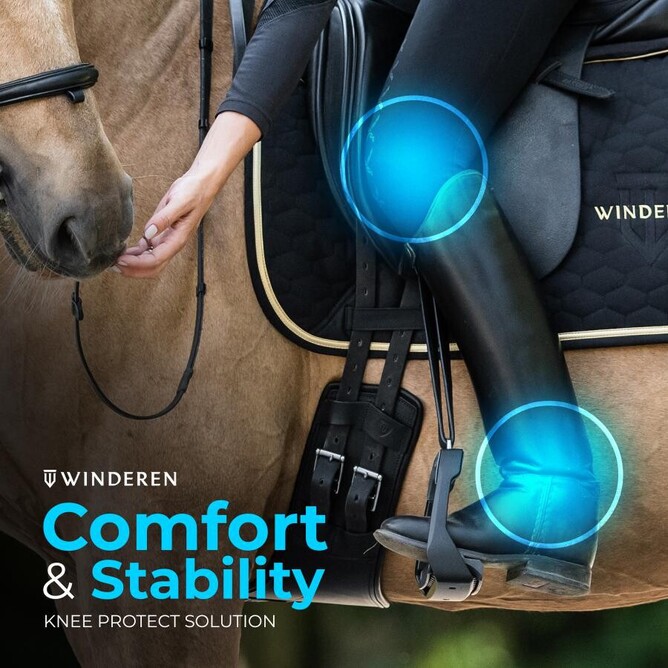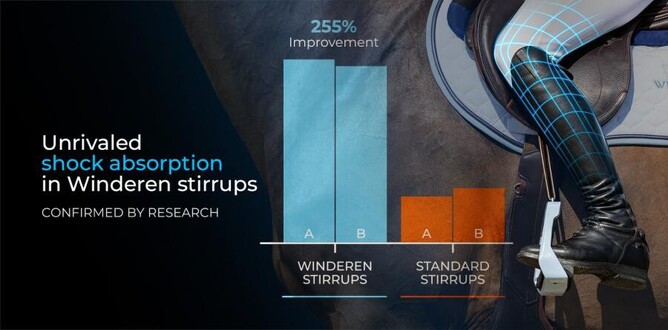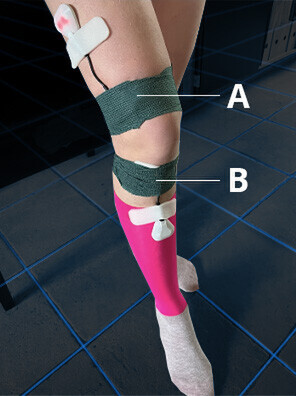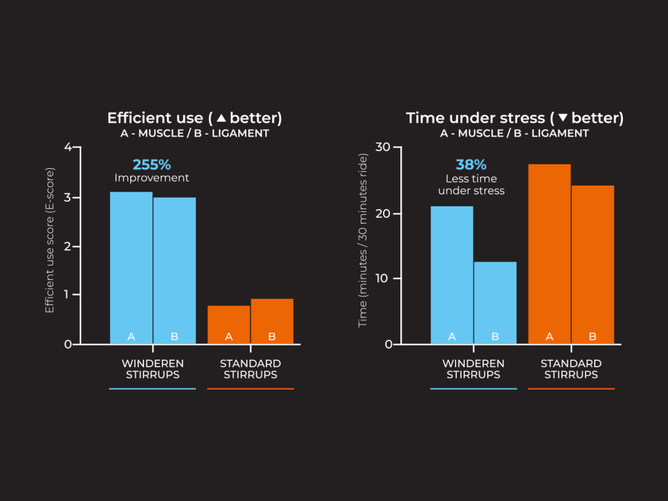Unrivaled Shock Absorption in Winderen Stirrups - Confirmed by Research
Riding is a discipline that is primarily based on the cooperation of the horse and rider. The rider's legs play a key role in communication with the horse, as their stable and correct placement in the stirrups is the basis for a good balance in the saddle.
At the same time, to keep the rider balanced, the legs work hard and have to endure very heavy loads, mainly due to dynamic interactions with the horse (directly) and the ground (indirectly) while riding. The rider's knee joints, which are responsible for shock absorption, are particularly exposed to significant and repetitive loads.
Therefore, the use of comfortable, innovative solutions aimed at ensuring the correct position of the leg in the stirrup and effective shock absorption support the protection of the knees and a stable seat, bringing benefits not only to riders, but also to their horses.
The Winderen Knee Protect Solution stirrups are designed to effectively support the shock absorption around the rider's knee joint. In order to confirm their effectiveness, we invited scientists from the University of Copenhagen to cooperation. They carried out a research project with our stirrups, comparing them to standard stirrups.
Twelve experienced show-jumping and eventing riders took part in the study using a modern diagnostic method, called acoustic myography. The acoustic myography has a number of practical applications, primarily as a research method.
It is non-invasive and easy to use, and allows you to monitor the activity of muscles and tendons in real time, informing about the effectiveness of their work, as well as about their physiological fatigue. A special sensor is placed on the surface of the examined anatomical structure, which "listens" to the sound emitted by the contracting fibers.
A graph appears on the screen of the smartphone or tablet, clearly showing the activity of the muscle or tendon during work.
The sensors were placed around the knee joint (A), specifically the muscle vastus lateralis (this is one of the heads of the quadriceps femoris muscle - the strongest extensor of the knee joint in humans), as well as on the patellar ligament (B), responsible for absorbing a significant part of the energy produced during movements made by the knee during load.
Recordings of the activity of the above-mentioned anatomical structures were conducted when riding at walk, trot and canter. This signal was analysed in real time by a team of specialists from the University of Copenhagen (Dr Adrian Harrison) and the Equi-Physiq company (MSc Marta Kulikowska).
The riders followed a previously agreed pattern of movement, riding in three basic gaits. In the first part of the study, they used standard stirrups and then repeated the pattern in the Winderen stirrups.
Already at first glance, significant differences were observed in the relief of the knee joint in favor of the Winderen Knee Protect Solution stirrups (blue graphs) compared to the standard stirrups (orange graphs).
A significant difference was indicated by the parameter Efficient use score (E-score), which means the shortening of the time the knee is exposed to loads and shocks. This shows that in a given period of activity, both the ligament and the muscle stabilising the knee joint experienced much lower loads with Winderen stirrups than with standard stirrups.
The Time Under Stress of the riders' quadriceps muscle (A) in Winderen stirrups was 14 seconds/min less in the walk and an average of 6 seconds/min less in trot and canter than in standard stirrups.
A similar observation was made for the patellar ligament (B) - here the time of its load was reduced by as much as 25 seconds/min in walk and by 10 seconds/min in trot and canter.
This means that the time the knee is exposed to loads and shocks while riding has been significantly reduced when using Winderen Knee Protect Solution stirrups. This is crucial especially for riders who need to be especially careful about overloading the knee joint, or for those who train intensively on a large number of horses per day.
In these situations, the reduction of the load time on the knee joint and the associated lower feeling of the forces exerted on the muscles and ligaments help to optimise the use of the leg and stabilise the foot in the stirrup, which translates into the overall comfort of riding and better work of the horse-rider pair.
Research confirms that Winderen stirrups significantly reduce knee loading time, thus reducing overload and increasing the efficiency of the leg muscles and joints. As a result, the rider gains a more stable leg position and better balance in the saddle, thereby significantly improving comfort for both the rider and the horse.
The riders participating in the study were asked for their opinion on the improvement of their riding comfort and the assessment of the difference in the use of Winderen Knee Protect Solution stirrups compared to standard stirrups. 11 out of 12 surveyed riders were positive about the Winderen Knee Protect Solution stirrups, and only one person admitted that she did not feel a significant difference compared to regular stirrups. Interestingly, her feelings did not translate into the results of measurements from her muscle and ligament, because these clearly showed a statistically significant difference.
The conclusions from the study clearly support the physiological benefits of using modern solutions in equestrian sport, such as the tested Winderen Knee Protect Solution stirrups.
The use of Winderen Knee Protect Solution stirrups compared to standard stirrups, reveals the following benefits:
A reduction of stress or strain time in the order of 14 seconds per minute of activity whilst walking and 5-7 seconds less whilst trotting or cantering for muscles around the knee.
A reduction of stress or strain time in the order of 25 seconds per minute of activity whilst walking and 9-10 seconds less whilst trotting or cantering for ligaments around the knee.
A significant improvement in the E-score (less time exposed to stress and shock) and ST-score (lower force around the knee) whilst walking.
A considerable improvement in rider comfort and feeling of leg stability (self-assessment) compared with the owners current stirrups, whilst riding.









